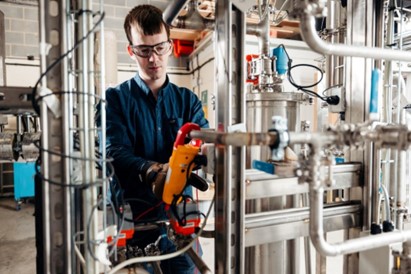-
C-Capture awarded £1.7m funding to demonstrate low-cost carbon capture solutions in hard-to-decarbonise industries
Date posted:
-
-
-
Post Author
Greg Kelsall
-
-

C-Capture’s Process Engineer, John Mackay with a carbon capture solvent compatibility unit. C-Capture in partnership with Wood Group, Castle Cement, Glass Futures and Energy Works (Hull) has been awarded £1.7m by the UK’s BEIS (Department for Business, Energy and Industrial Strategy) to develop next-generation carbon capture technology. The funding is part of the £20m Carbon Capture, Usage and Storage (CCUS) Innovation 2.0 programme aimed at accelerating the deployment of next-generation CCUS technology in the UK, a component of the BEIS £1 billion Net Zero Innovation Portfolio (NZIP). CCUS has been identified as an essential component in the route to decarbonisation, although challenges to full commercial roll-out exist in the form of technology maturity, flue gas compatibility in multiple industries and cost.
The project called ‘XLR8 CCS Accelerating the deployment of a low cost carbon capture solution for hard to abate industries’ will deliver feasibility studies and deploy carbon capture solvent compatibility units across the cement, energy from waste and glass industries. All three of these applications are described as challenging to decarbonise due to the level and type of impurities in their flue gases.
The compatibility of C-Capture’s solvent-based technology will be trialled and assessed with flue gas at sites owned by Hanson Cement, part of the Heidelberg Group, Bioenergy Infrastructure Group (BIG), Glass Futures and one of their member sites Pilkington UK.
Glass and cement industries are essential to global economies but are also major CO2 contributors. Concrete for example is the second most utilised material globally behind water, with cement being one of its key components. The global cement and concrete products market is valued at around $440 billion and produces over 2.5 GtCO2/y globally. CCUS has been identified as the single largest lever to decarbonise the industry, potentially achieving 36% of the sectors net zero ambition by 2050 according to the Global Concrete and Cement Association.
Energy from waste plants offer a solution to residual waste, whilst helping to meet the demand for low-carbon energy by converting waste that would otherwise be sent to landfill, into power for homes. Incorporating carbon capture into the process could further lower emissions of the sector and, in cases where waste wood material is used as fuel, allow it to achieve negative CO2 emissions.
Tom White, CEO at C-Capture said “The amount of CO2 being generated and released into the atmosphere is currently at a scale that is hard to imagine. The deployment of carbon capture technology is essential – and urgent – to achieve net zero by 2050. Our solution has the potential to be a game changer for carbon capture. It uses less energy than currently available technology meaning it can significantly reduce the cost of carbon capture to a point that makes it affordable globally. It is also environmentally benign, well suited to the large-scale capture of CO2 and robust enough to withstand even the most aggressive flue gases. These advantages mean it has potential to break the barriers that are preventing the widespread adoption of carbon capture and storage technology, to mitigate the impacts of climate change.”
The C-Capture process is reported as requiring 40% less energy than other solvent based carbon capture technologies, significantly reducing its cost. As reported in previous IFRF blog-posts, the technology has been trialled at the Drax BECCS project and is a potentially suitable technology for the glass industry.
As noted above, the C-Capture technology is due to be trialled at Hanson’s Ketton cement works in Rutland, UK.
![]()
Simon Wills, Hanson CEO, said “Carbon capture is a critical part of our strategy to decarbonise cement production and essential if we are to reach next zero carbon by 2050. Our Padeswood cement works in north Wales is already part of the HyNet North West carbon capture and storage project and this new venture at our Ketton works is another example of our commitment to developing new technologies. If successful, the C-Capture process has the potential to be rolled-out across other sites across the Heidelberg Cement Group.”

